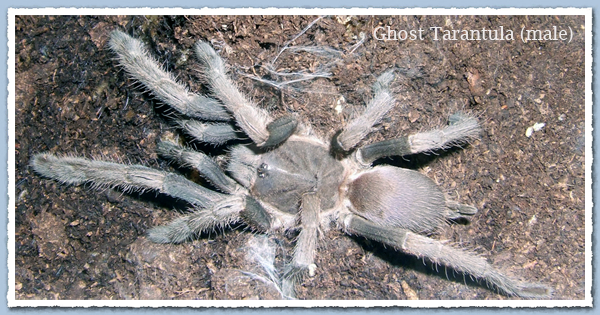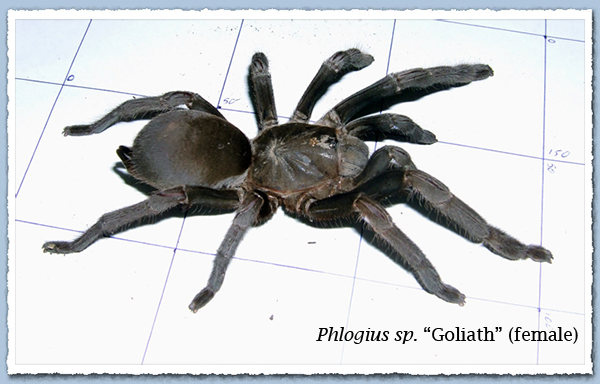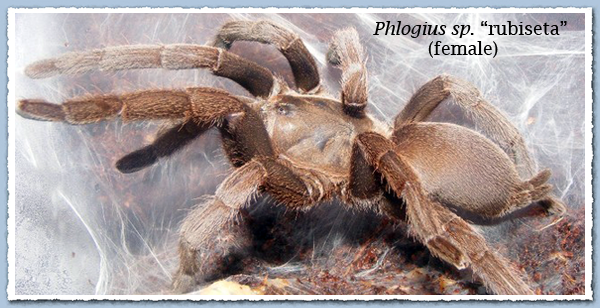Until then it is worth noting the very exciting discoveries or rediscoveries of tarantula species that have been made in the last 12 months.
Brendan Stent of Tropical Tarantulas found a possible new genus named tentatively the Rattlesnake Tarantula in February 2008. This amazing species makes a sound simlar to a rattle snake when aggravated. Apparently Rob Raven knew of this species but Brendan was the person that first brought this species to the public which makes it one very exciting discovery by Brendan. Brendan also found another species which appears to be somewhere between Selenotypus plumipes and Selenotypus sp. "Nebo" and has been given the placeholder name Selenotypus sp. "plumebo". The video shows the Rattlesnake Tarantula using its unique stridulating organ to produce its characteristic rattler sound.
YouTube video of Rattlesnake Tarantula filmed by Brendan Stent
Another interesting species that surfaced in 2008 is the Ghost Tarantula announced by Steve Nunn in June 2008. This species has a unique pale colour with white setae which is very unusual for Australian tarantulas. In addition it was found in swamp habitat. Unfortunately the single specimen that was collected moulted out to a male so at present an active captive breeding program has not been commenced. It will take another collecting mission to get this species breeding in captivity but it will certainly be a very highly sought after species due to its colour.
Ghost Tarantula - Photo by Steve Nunn
In a year of big discoveries and new species perhaps the biggest impact on Australian enthusiasts was made by Steve Nunn’s announcement of the discovery by a collector of Phlogius sp. "Goliath" or the Australian Goliath Tarantula. This species is possibly the largest species discovered to date and reaches at least 20cm as a mature adult. I managed to acquire a couple of specimens of the Goliath that were not required for the breeding program that was immediately established and they are truly a fascinating species. Steve advises that this was actually a rediscovery of a species not seen for 103 years despite attempts to locate it and that there is only a single specimen in the Queensland Museum (Australia) incorrectly labelled as Phlogius crassipes. Several matings have been reported by those involved in the breeding program led by Steve and we are waiting impatiently for the first spiderlings to appear. Greg Bylund, of the Green Scorpion, produced the first captive bred eggsac in July 2008 but unfortunately the female ate the eggs before he had a chance to remove the sac for incubation. Greg and Steve have other gravid females and spiderlings are expected by December 2008. This was the first time that a captive breeding program was established at the outset and is a model that will hopefully be reproduced in the future.
Phlogius strenuus is another giant that is rare in collections but has been bred in 2008 by Greg Bylund and Grant Miller. No doubt other individuals will also be breeding this species in 2008. Its captive breeding status is secure for now. This species although not a new discovery is highly sought after and thus the successful captive breeding program has been an initiative of tremendous importance. There have been other giants found this year but as they have not been publicly announced I will hold fire on making an announcement on this site.
The tentatively named Phlogius sp. "Rubiseta" (yes I know that doesn't quite work but its only a placeholder name) was announced by Greg Bylund in March 2008. There has been some discussion to date as to whether this is a new species or whether it is synonymous with the previously discovered Stents Tarantula however we will know soon enough the eventual outcome. The redish colouration makes this a very attractive tarantula.
Greg Bylund announced the discovery of an entirely new genus in September 2008 in the form of the tentatively named JT Tarantula. A new genus is certainly big news. This species lives in very harsh dry conditions and is an incredible discovery. Early reports from keepers are that this is a very docile species which should make it very popular indeed.
JT Tarantula and burrow - photo by Greg Bylund
Just this month Brendan announced another species he discovered which has been named the Banded Phlogius. This is another very fine looking species with fine bands of white setae at the end of leg segments which are especially noticeable on legs I and II.
Two persistent rumours continue to circulate. One relates to a nearly pure white form of tarantula, whiter than the Ghost Tarantula, and another relates to a metallic blue tarantula. It would not surprise me if one or both of these rumours turn out to be correct as most of Australia is unexplored for tarantulas and new species are being found at an amazing rate. Given Australia’s geological history I would not even be surprised to hear the Selenosmia dichromata turned up somewhere in the northern tropics of Australia.










Are there any in Australia in size compared to that of the Amazon Goliath Tarantula, which is supposedly the Biggest Tarantula in the world so far? And could it be possible to discover another kind of spider that isnt tarantula but still another Large family equivalent or bigger than the Tarantula Species that is yet to be discovered?
ReplyDeleteNah, nah, nah mate, there not the same size.
DeleteThus far mate there is no sp in aus that get the 12 inch Legspan, one huntsman species gets to over 210mm but so far the biggest T in aus i've seen was 220mm 8cm off the Blonie.. not bad in my opinion.
ReplyDeleteNah, nah, nah mate 223mm
DeleteThat was a Phlogius Strennus Btw
ReplyDeleteI heard from someone today that the tweed valley shire council have discovered that someone has been releasing south american Goliath tarantulas into the wild throughout the Carool Bilambil Hills and are being discovered regularly,some idiot that did that, there now worried they could be multiplying rapidly and have dispatched a team to try and eradicate them quietly.
ReplyDeleteWhat temperature should a Phlogius Goliath should be, I have one and in Sydney is now rather cold. I am able to keep her between 23 and 25C. and about 85% humidity Is that enough
ReplyDeletethanks!
Nah, nah, nah mate between 24 and 26 degrees and 86% humidity
DeleteThose spiders are nothing compared to the ones my Uncle has because he has discovered a new species.
ReplyDeleteI had a large, slow moving,silver gray,furry spider walk into my kitchen last summer.could it have been a tarantula? I live 35k east of the flinders ranges on the Willocra plain. SA.
ReplyDeleteNah, nah, nah mate not possible, not down there..
DeleteDuring the floods in south east Queensland I saw a large tarantula like spider crossing a walking track at my property near Stanthorpe on the Granite Belt. The land was waterlogged so like the rabbit burrows I imagine its burrow was also flooded. My recollection was that the it was about 8 or 9 cm (not including legs), very meaty looking, hairy with thick legs. It was quite pale with stripes, I can't remember if the stripes were across the abdomen or just on the legs like the Ghost Tarantula. I tried to photograph it but unfortunately as I was reaching for my phone I said to my 4 yo on my shoulders "there's a bloody big spider" and then needed to try and stop him catapulting himself over the top of my head trying to see the spider. While I was happy to look at it on the walking track, I was not so keen to pursue it into the undergrowth. What might it me?
ReplyDeleteSelenocosmia crassipes maybe? They are native to Queensland and apart from the stipes it sounds like the one you are talking about, not sure however on the 9cm body length ive never heard of one that big. Maybe because it was such a rare sight you remember it bigger then it was? I have one of these species at the moment and its around 16cm including legs and to my understanding thats about as big as they get.
ReplyDelete